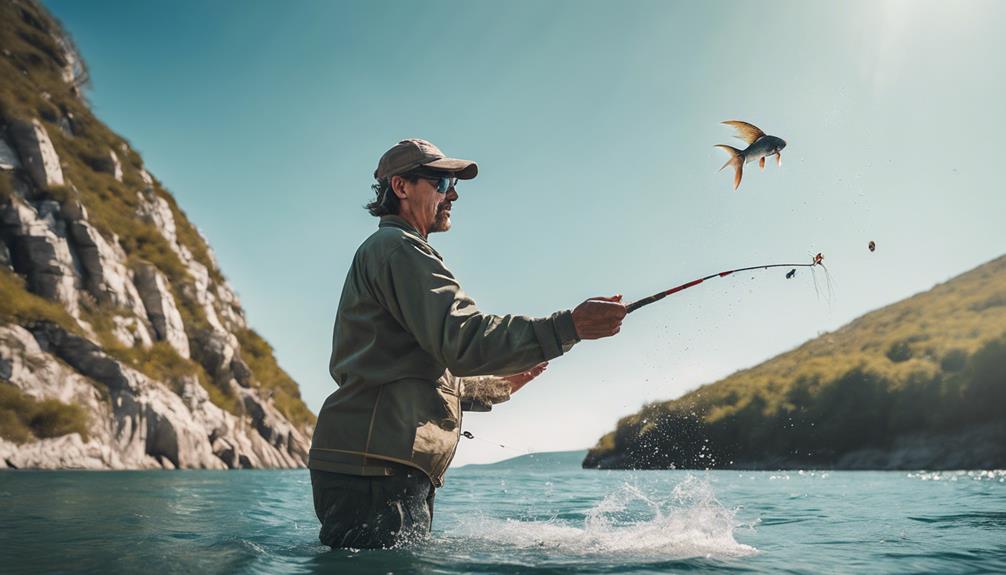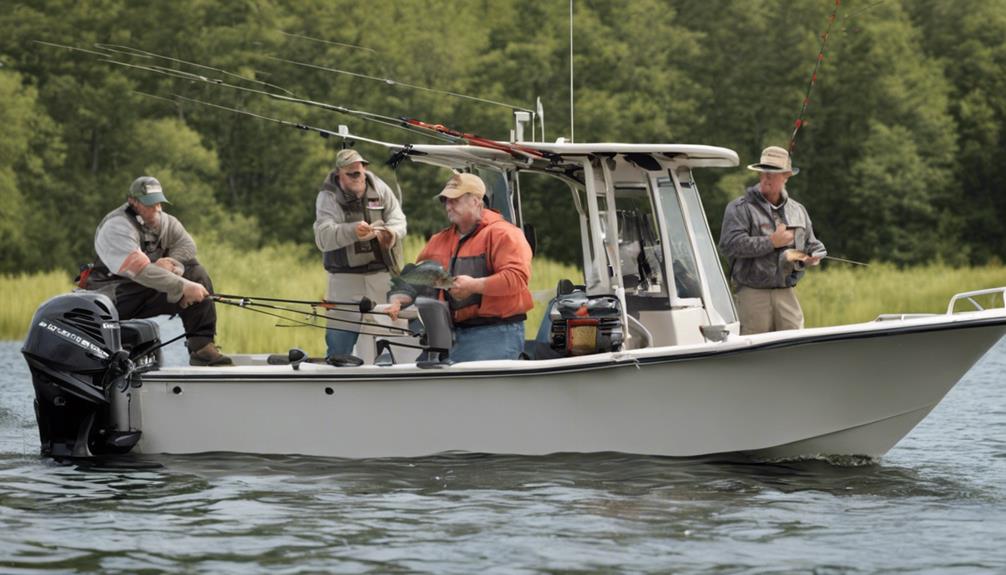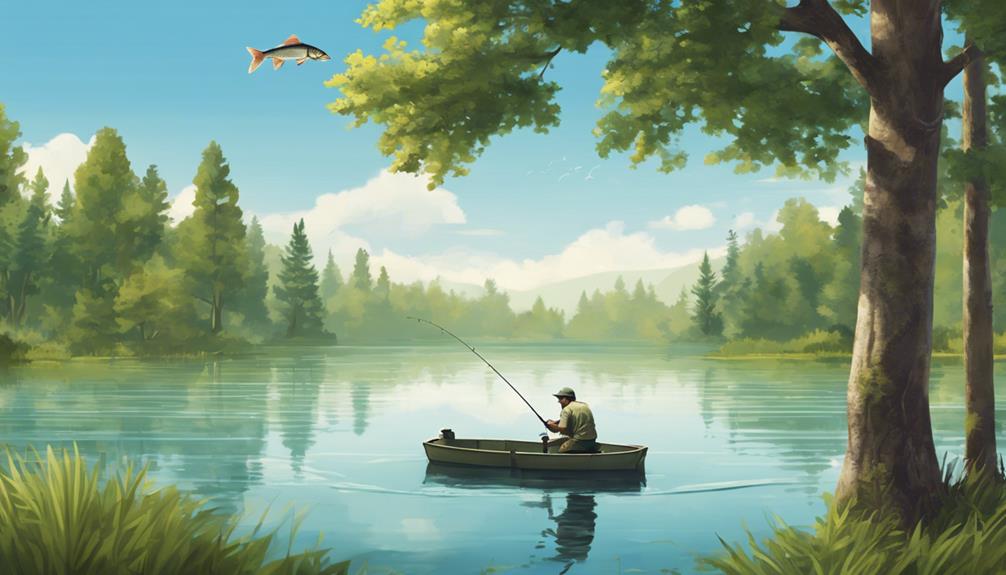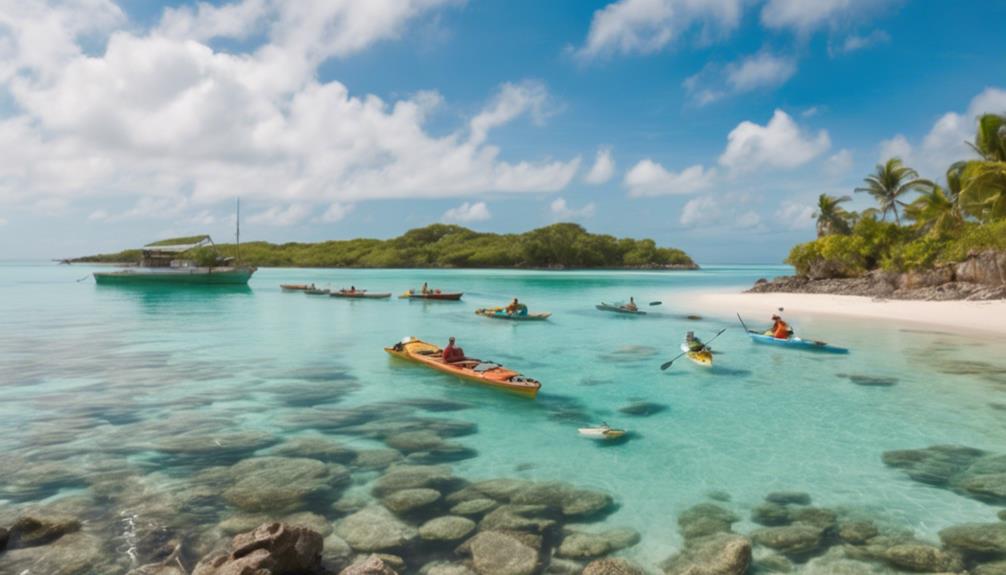Imagine you're out on the water, enjoying a day of fishing.
But did you know there are simple practices you can adopt to ensure your fishing activities are sustainable and conservation-focused?
These five best practices not only help protect marine ecosystems but also contribute to the longevity of fish populations.
By implementing these strategies, you can make a positive impact on the environment while still enjoying your favorite pastime.
So, what are these practices, and how can they benefit both you and the oceans?
Selective Harvesting Methods
When fishing, prioritize using selective harvesting methods to help preserve fish populations and maintain a sustainable ecosystem. By practicing selective harvesting, you contribute to habitat preservation and maintain ecosystem balance. This method involves carefully choosing which fish to keep and which to release back into the water. By doing so, you play a crucial role in species conservation and promote healthy fish populations.
Selective harvesting also involves following size limits set by regulations. These limits are designed to ensure that fish have the opportunity to reproduce before being caught. By adhering to size limits, you allow fish to reach maturity and contribute to the next generation, thus supporting species conservation efforts. This practice helps in maintaining a diverse and thriving ecosystem by allowing fish to grow and reproduce naturally.
Implementing selective harvesting methods not only benefits fish populations but also contributes to the overall health of the aquatic environment. By being mindful of the fish you keep and releasing undersized or excess catch, you actively participate in preserving the delicate balance of the ecosystem. Your actions make a difference in promoting sustainable fishing practices and ensuring that future generations can also enjoy the wonders of fishing.
Implementing Catch Limits
To promote sustainable fishing practices, it's essential to adhere to catch limits set by regulations. Catch limits are crucial for maintaining fish populations at healthy levels and preventing overfishing. Monitoring compliance with these catch limits is key to their effectiveness. By ensuring that fishermen stay within the specified limits, authorities can safeguard the sustainability of fish stocks for future generations.
Data collection plays a vital role in implementing catch limits successfully. Accurate and up-to-date data on fish populations and catch levels are necessary to establish appropriate limits. Regular monitoring and analysis of this data help authorities make informed decisions when setting or adjusting catch limits. Additionally, public education is essential to raise awareness about the importance of adhering to catch limits. By educating fishermen and the wider community on the reasons behind catch limits and their role in conservation, compliance can be improved.
Community engagement is another critical aspect of implementing catch limits. Involving local communities in the decision-making process can lead to greater acceptance and support for these regulations. Collaborating with fishermen, conservation groups, and other stakeholders can help foster a sense of shared responsibility for sustainable fishing practices. Overall, effective implementation of catch limits requires a combination of monitoring compliance, data collection, public education, and community engagement.
Using Biodegradable Fishing Gear
Implementing biodegradable fishing gear in your practices can significantly reduce the environmental impact of fishing operations while contributing to the conservation of marine ecosystems. By choosing eco-friendly alternatives and sustainable fishing practices, you can make a positive difference in protecting the oceans.
Here are some key points to consider when using biodegradable fishing gear:
- Environmental Impact: Traditional fishing gear, such as nylon fishing lines and plastic nets, can have detrimental effects on marine life and habitats. Opting for biodegradable options, such as lines made from natural fibers or nets that break down harmlessly, helps decrease the pollution and harm caused by abandoned or lost gear.
- Biodegradable Options: Explore the market for biodegradable alternatives to common fishing gear components. Look for biodegradable fishing lines, hooks made from sustainable materials, and biodegradable bait containers. These options break down over time, reducing the amount of waste that ends up in the oceans and posing less risk to marine animals.
- Sustainable Practices: Incorporating biodegradable fishing gear into your routine aligns with sustainable fishing practices. By reducing your environmental footprint and choosing gear that's less harmful to marine ecosystems, you can actively participate in the conservation of marine life for future generations.
Supporting Marine Protected Areas
Support Marine Protected Areas by actively engaging in conservation efforts and advocating for their preservation. These areas play a crucial role in safeguarding marine biodiversity and ecosystem health. One way to support Marine Protected Areas is through community involvement. By participating in local clean-up initiatives, volunteering for monitoring programs, or joining conservation organizations, you can contribute to the protection of these vital marine habitats. Additionally, forming eco-tourism partnerships can help generate sustainable funding for the management and enforcement of Marine Protected Areas, while also promoting awareness and appreciation for marine conservation.
Educational outreach is another essential aspect of supporting Marine Protected Areas. By educating others about the importance of these areas and the role they play in preserving marine life, you can help foster a culture of conservation. Furthermore, engaging in policy advocacy is crucial for ensuring the effective management and expansion of Marine Protected Areas. By advocating for stronger regulations, increased enforcement, and the creation of new protected areas, you can help secure a brighter future for our oceans.
Avoiding Overfishing Hotspots
Engage in sustainable fishing practices to avoid overfishing hotspots and protect marine ecosystems. By being mindful of where you fish and how you do it, you can make a significant difference in preserving our oceans for future generations.
Here are some key strategies to help you avoid overfishing hotspots:
- Understand the Impact: Educate yourself on the importance of fishing sustainability and the consequences of overfishing. By being aware of the issues at hand, you can make informed decisions that support marine conservation efforts.
- Utilize Technology: Take advantage of modern tools and technologies to track fish populations and locate sustainable fishing grounds. By using sonar devices or fish finders, you can avoid overfished areas and reduce your impact on vulnerable species.
- Support Conservation Efforts: Get involved in local conservation initiatives and support organizations that promote sustainable fishing practices. By joining forces with like-minded individuals and groups, you can work together to protect marine ecosystems and prevent overfishing hotspots from worsening.
Engaging in Responsible Angling Practices
To ensure the sustainability of marine ecosystems, adopt responsible angling practices that prioritize conservation and ethical fishing methods. Engaging in responsible angling practices involves more than just catching fish; it requires a mindful approach towards ethical consumption and reducing your environmental impact. By following fishing regulations and guidelines, you can play a crucial role in maintaining ecosystem balance and protecting marine biodiversity.
When engaging in angling activities, consider the environmental impact of your actions. Avoid using harmful fishing gear that can damage marine habitats or harm non-targeted species. Opt for sustainable fishing practices such as catch-and-release to minimize your impact on fish populations. Additionally, be mindful of your waste and dispose of it properly to prevent pollution in the waters.
Furthermore, practicing ethical consumption means being selective in the fish you target. Avoid overfishing vulnerable species or those that are already overexploited. By making informed choices about the fish you catch and consume, you contribute to the preservation of marine ecosystems.
Remember that fishing regulations are in place for a reason. Familiarize yourself with local fishing laws and adhere to catch limits to prevent overexploitation. Respecting these regulations not only ensures the sustainability of fish stocks but also promotes responsible angling practices for future generations to enjoy.
Participating in Fish Stock Monitoring

By actively monitoring fish stocks, you can contribute valuable data to help assess the health of marine populations and inform sustainable fishing practices. This involvement not only benefits the environment but also enhances your understanding of marine ecosystems.
Here's how you can participate effectively:
- Contribute to Data Accuracy: Engaging in citizen science initiatives allows you to collect and report data on fish populations. Your observations help scientists and fisheries managers make informed decisions regarding conservation efforts and fishing regulations. By actively participating, you play a crucial role in ensuring the accuracy of data used to assess fish stocks.
- Embrace Technology for Remote Monitoring: Utilize technology such as apps, satellite tracking, and underwater drones to monitor fish populations remotely. These tools provide real-time data on fish movements, population sizes, and habitat preferences. By leveraging technology, you can contribute to fish stock monitoring efforts without disturbing marine environments.
- Engage in Collaborative Monitoring Programs: Join forces with local organizations, research institutions, or government agencies involved in fish stock monitoring. Collaborative programs often provide training, resources, and a platform to share your findings with a wider audience. By working together, you can amplify the impact of your monitoring efforts and contribute to conservation on a larger scale.
Promoting Sustainable Fishing Practices
Implement sustainable fishing practices to protect marine ecosystems and secure the future of fisheries. By engaging in fishery education programs and forming community partnerships, you can actively contribute to the conservation of aquatic resources. These initiatives provide valuable knowledge on sustainable fishing methods, helping you make informed decisions when out at sea.
Additionally, promoting ethical consumption is vital in ensuring the longevity of fish populations. By choosing eco-friendly alternatives such as using biodegradable gear and supporting sustainably sourced seafood, you directly impact the health of marine environments. Encouraging others to make responsible seafood choices further amplifies the positive effects of sustainable fishing practices.
Fishery education programs offer insights into the importance of adhering to catch limits, avoiding bycatch, and respecting marine protected areas. Through community partnerships, you can collaborate with local organizations to implement regulations that safeguard vulnerable species and habitats. Working together, you create a ripple effect that benefits both present and future generations of fishers.
Incorporating eco-friendly alternatives into your fishing routine not only minimizes environmental harm but also sets a precedent for others to follow. By embracing sustainable practices and advocating for change within your community, you become a steward of marine conservation, preserving aquatic ecosystems for years to come.
Frequently Asked Questions
How Can Recreational Fishermen Contribute to Conservation Efforts Beyond Following Catch Limits and Using Biodegradable Gear?
To contribute more to conservation efforts, think beyond catch limits and gear. Get involved in your community, spread awareness, and advocate for sustainable practices.
Participate in beach clean-ups, support marine protected areas, and educate others about responsible fishing. By engaging with local initiatives and promoting sustainable fishing methods, recreational fishermen can make a significant impact on conservation efforts beyond just following regulations.
Are There Any Specific Regions or Types of Marine Environments Where Conservation-Focused Fishing Practices Are Especially Important?
In specific regions like coral reefs, your conservation-focused fishing efforts can have a global impact. Protecting these biodiverse hotspots is crucial for marine life.
Similarly, in deep-sea environments, your actions can help preserve biodiversity. By adopting responsible fishing practices in these areas, you contribute to the overall health of marine ecosystems.
What Role Do Government Regulations Play in Ensuring Sustainable Fishing Practices and Conservation Efforts?
Government regulations play a crucial role in ensuring sustainable fishing practices. They set limits on catch sizes, regulate fishing seasons, and establish protected areas. These rules help conserve fish populations and protect marine ecosystems.
Additionally, government regulations often encourage community involvement in conservation efforts, fostering collaboration between authorities, fishermen, and environmental groups to achieve long-term sustainability in fishing practices.
How Can Fishermen Educate Others in Their Community About the Importance of Conservation-Focused Fishing?
To educate others in your community about conservation-focused fishing, engage in community outreach through educational workshops.
Use social media campaigns and peer-to-peer advocacy to spread awareness.
Share knowledge about sustainable fishing practices and the importance of conservation efforts.
Are There Any Specific Techniques or Technologies That Can Help Fishermen Reduce Bycatch and Protect Non-Target Species?
To reduce bycatch and protect non-target species, fishermen can utilize technological innovations like TEDs and circle hooks. These tools help prevent accidental capture of marine life while fishing.
By implementing these bycatch reduction techniques, you can actively contribute to conservation efforts and sustain healthy fish populations for the future.
Embracing these methods ensures responsible fishing practices and promotes a more sustainable approach to fishing.
Conclusion
By following these best practices for conservation-focused fishing, you can play a crucial role in protecting our marine ecosystems and ensuring sustainable fish populations for future generations.
Selective harvesting methods, implementing catch limits, using biodegradable gear, supporting protected areas, and avoiding overfishing hotspots are all key actions that can make a positive impact.
Remember, every small effort counts towards preserving our oceans and marine life. Keep up the good work!



